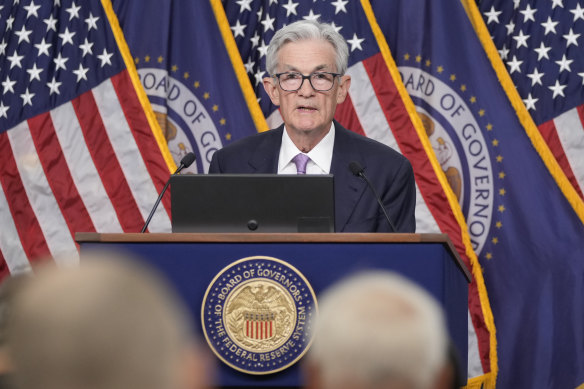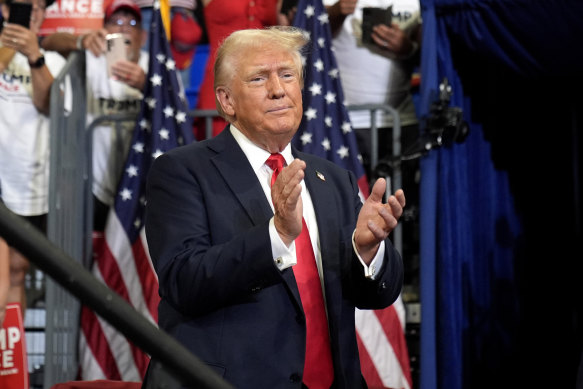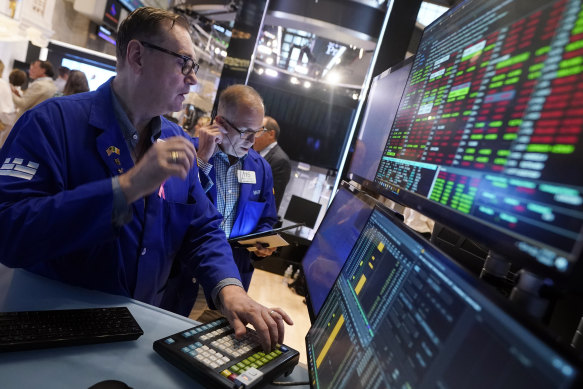Opinion
How Trump could destroy the Fed’s grand plan
Stephen Bartholomeusz
Senior business columnistShould the Federal Reserve Board’s decision to start a US rate-cutting cycle with a bang be regarded as an alarm bell or as an admission of error?
Three months ago, at its June meeting, the Fed’s Open Market Committee (FOMC), which decides monetary policy, ignored calls for a rate cut and pencilled in only a single 25 basis point rate cut this year.

Fed chair Jerome Powell said he doesn’t believe that the central bank has left it too late to start cutting rates. Credit: AP
Now, after announcing an oversized 50 basis point cut, the median projection of the FOMC members is for another 50 basis points of cuts from its November and December meetings.
While the big shift in the Fed’s stance could be read as a concern that the US economy is deteriorating at a rate not foreseen back in June, that’s not a view supported by the other projections released with the announcement of the rate cut.
While the FOMC members see marginally slower growth (downgraded from 2.1 per cent to 2 per cent), higher unemployment (upgraded from 4 per cent to 4.4 per cent) and lower core inflation (revised down from 2.8 per cent to 2.6 per cent), those aren’t the settings of a distressed economy and the projections for next year are similarly benign and reflective of the much-sought-after soft landing.
That suggests that the Fed, having seen the unemployment rate edging up and the inflation rate edging down since the June meeting, has recognised what financial markets were signalling three months ago.
It had fallen “behind the curve” by its inaction and needed to play catch-up by ignoring the conservative option of a 25 basis point cut to start the rate-reducing cycle.
As it happens, the markets got it right again. After dithering over whether the Fed would cut by 25 or 50 basis points for weeks, in recent days the futures markets had been pricing in a near-70 per cent chance of the larger cut.
That explains why, after an initial spike as the rate cut was announced, the share and bond markets were relatively flat on Wednesday. The size of the cut, however, ought to provide something of a floor under the sharemarket.

A Trump election victory could scupper the Fed’s economic projections.Credit: AP
Fed chair Jerome Powell wasn’t prepared to concede that its timing was a little out.
“We do not think we are behind [in starting to cut rates],” he said at a press conference after the FOMC’s statement.
“But you can take this as a sign of our commitment not to get behind.
“The US economy is in a good place and our decision today is designed to keep it there.
“This recalibration of our policy stance will help maintain the strength of the economy and the labour market and will continue to enable further progress on inflation as we begin the process of moving towards a more neutral stance.”
Given the history of the Fed’s projections and how quickly they can be rendered irrelevant by developments within the economy, there is no guarantee that the Fed’s relatively optimistic outlook for the next couple of years will materialise – particularly as the outcome of the November election could see massive and potentially disruptive, even destructive, changes in economic policies.
A soft landing does, however, appear attainable under the current settings and the Fed has the flexibility to respond to whatever happens after November.
The rate cut ends what has been a two-and-a-half year period of increasingly restrictive US monetary policy, a period which saw the federal funds rate lifted from near-zero during the pandemic years to a range of 5.25 to 5.5 per cent in July last year, where it has remained.
That was a response to an inflation rate initially fuelled by the pandemic’s disruption of global supply chains and the fiscal largesse showered on households and businesses during that period.
US inflation hit 9.1 per cent two years ago but has been falling back steadily in response to interest rates that, in real terms, have been rising as the inflation rate fell. If the Fed hadn’t moved this week, there would have been a very real risk that those rising real rates would have choked the US economy.

The size of the cut should provide something of a floor under the sharemarket.Credit: AP
Given that the cost of living has been a major issue in the run-up to the November elections, the Fed’s decisive move has obvious political implications, which the Fed would have been conscious of.
Asked about the sensitivity of the cut so close to the election, Powell said this was his fourth presidential election since he joined the Fed.
“Our job is to support the economy on behalf of the American people,” he said.
“We don’t put up any other filters. If we start to do that, I don’t know where we stop.”
Nevertheless, the rate cut does have political implications, with Joe Biden and Kamala Harris quick to welcome it.
President Biden described it as an important moment for the economy, with inflation and interest rates falling while the economy remained strong.
“The critics said it couldn’t happen, but our policies are lowering costs and creating jobs,” he said.
Leaving aside the economics and what the size of the rate cut might say about the condition of the US economy, the start of a rate-cutting cycle, along with petrol prices that have been falling significantly, are clearly pluses for Harris and the Democrats, given how front-of-mind the costs of living have been in US households.
Donald Trump, who wants influence over the Fed’s decision-making and has said he won’t reappoint Powell as chair when his term expires in 2026, naturally put a very different spin on it.

The Fed is trying to engineer a soft landing for the US economy.Credit: Bloomberg
“I guess it shows the economy is very bad to cut it by that much, assuming they’re not just playing politics. The economy would be very bad or they’re playing politics; one or the other. But it was a big cut,” he said.
Trump’s policies – a baseline tariff of up to 20 per cent on all imports and a 60 per cent duty on imports from China; the mass detention deportation of immigration and tax cuts for companies, wealthy households, waiters and overtime workers – would radically change the outlook for the US economy and because they would be highly inflationary, and would raise US interest rates.
If the Fed hadn’t moved this week, there would have been a very real risk that those rising real rates would have choked the US economy.
Harris’ agenda, while not as radical, would also be big-spending. The projections for interest rates and the economy, where it sees real GDP growth settling at 2 per cent over the next couple of years, could be quickly over-taken by events.
If things play out as the Fed currently projects, it will have implications beyond the US borders because shifts within the US economy, US financial markets and US inflation and interest rates reverberate through the global economy and financial markets. A soft landing for the US and falling interest rates are positive for the global economy and markets.
The International Monetary Fund has estimated that when US interest rates were rising each percentage point increase in US Treasury bond yields flowed through to as much as a 90 basis point rise in other advanced economies, with persistent consequences. For emerging markets, there was an almost complete flow-through.
Now that US rates are subsiding, it is conceivable that it will have broadly similar effects in the other direction, aiding global growth, impacting capital flows and currency relativities and shrinking the impact of a key external influence on other central banks’ decision-making. At the margin, it could help lower global interest rates.
The Fed might have been a bit slow off the mark, but the start of a rate easing cycle in the US isn’t just good news for American businesses and households.
The Market Recap newsletter is a wrap of the day’s trading. Get it each weekday afternoon.